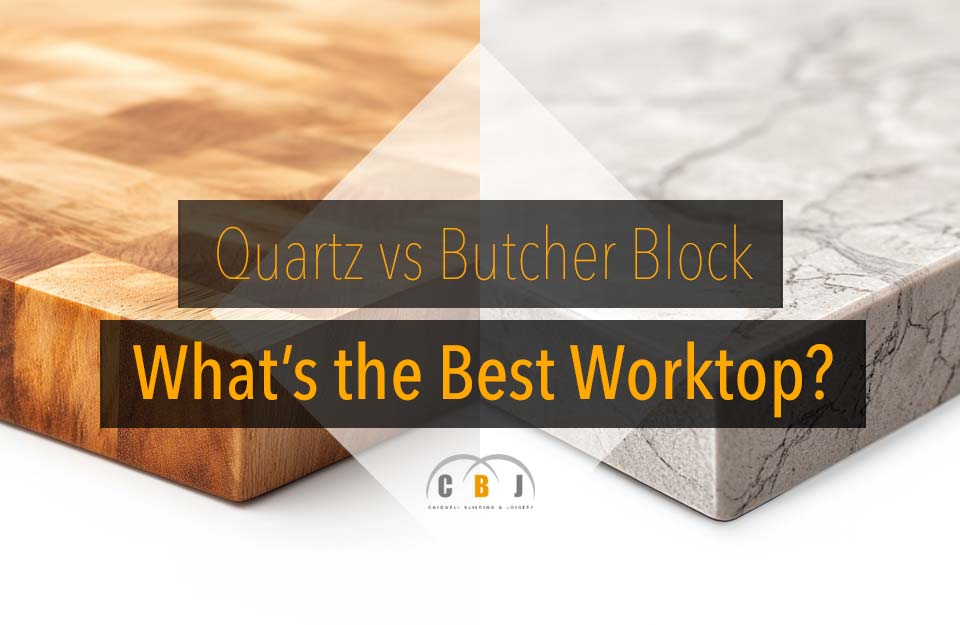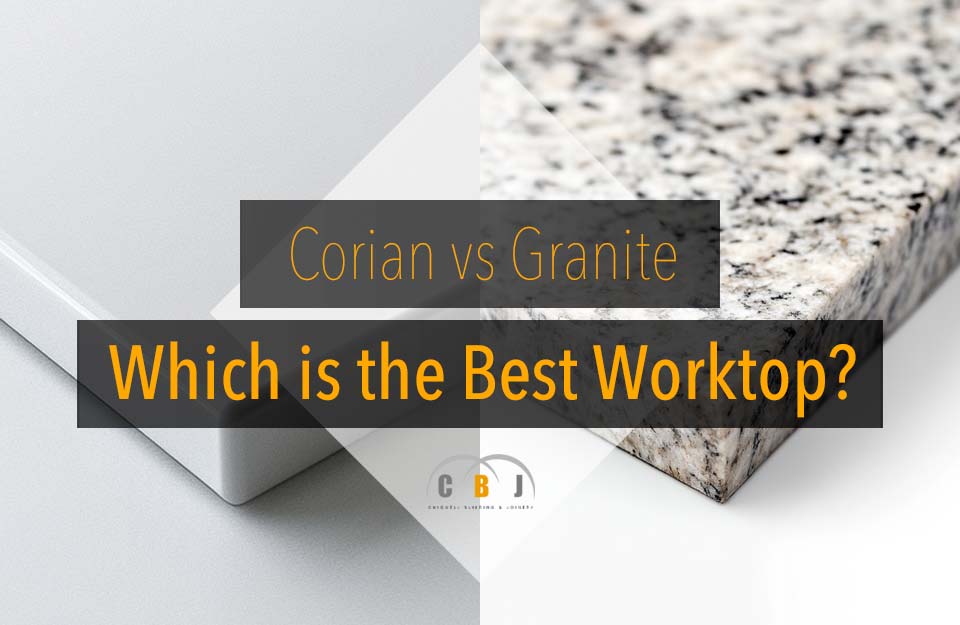News
Quartz vs Butcher Block - What's the Best Worktop?
Author Chigwell Building & Joinery
Date 15/04/2025
When installing brand new kitchen cabinets, choosing the right worktop is a crucial decision that affects both aesthetics and functionality.
Among the most popular choices are quartz vs butcher block countertops, each offering distinct advantages and challenges.
Whether you're looking for durability, low maintenance, or a warm and natural aesthetic, this guide will help you understand the differences and make an informed decision.
Table of Contents
- What is Butcher Block?
- What is Quartz?
- Origins
- Appearance
- Imperfections
- Durability
- Stain Resistance
- Marks and Scratching
- Maintenance and Care
- Heat Resistance
- Strength
- Longevity
- Water Resistance
- Design
- Installation
- Cost
- Added Value
- Conclusion
What is Butcher Block?
Butcher block countertops are crafted from solid wood, typically made by bonding strips of hardwood such as maple, oak, cherry, or walnut.
This creates a sturdy and visually appealing surface with natural grain patterns and warm tones.
Originally designed for heavy-duty kitchen tasks, butcher block worktops have found their way into modern homes, offering a timeless, rustic charm.
However, as a natural material, wood requires regular maintenance to keep it looking its best and to prevent damage from moisture and wear.
What is Quartz?
Quartz countertops are engineered surfaces made from natural quartz crystals combined with resins and pigments to create a highly durable, non-porous material.
Unlike natural stone, quartz worktops are manufactured to provide a consistent appearance, making them a preferred choice for homeowners seeking a sleek, modern aesthetic.
Available in a wide range of colours and patterns, quartz can mimic the appearance of marble, granite, or other natural stones without the drawbacks of high maintenance.
Origins
The primary distinction between these two materials lies in their composition.
Butcher block is sourced from natural hardwood, while quartz is an engineered material designed for enhanced strength and consistency.
This difference affects everything from durability to maintenance and overall appearance.
Appearance
If you’re drawn to a warm, natural look, butcher block offers a rich, organic aesthetic with unique grain patterns that add character to any kitchen.
Over time, the wood develops a patina, enhancing its charm.
Quartz, on the other hand, provides a sleek and polished finish, ideal for modern and contemporary designs.
With an extensive selection of colours and patterns, quartz allows for greater customisation without the imperfections that come with natural materials.
Imperfections
Because butcher block is made from real wood, it often features natural knots, streaks, and variations in colour.
While many homeowners appreciate these imperfections for their rustic appeal, others may find them less desirable.
Quartz, being a man-made material, is designed to be uniform, free from natural inconsistencies, ensuring a flawless look throughout the surface.
Durability
While both materials are durable, quartz has the upper hand when it comes to resistance against wear and tear.
Its engineered composition makes it highly resistant to scratches, chips, and cracks.
Butcher block, on the other hand, is softer and more susceptible to dents and scratches, though minor damage can often be sanded out and refinished.
Stain Resistance
One of the biggest drawbacks of butcher block is its porosity, making it vulnerable to stains if not properly sealed.
Liquids, particularly oil and wine, can seep into the wood and cause discolouration.
Quartz, being non-porous, is highly resistant to stains and does not require sealing, making it a hassle-free option for busy kitchens.
Marks and Scratching
Unlike quartz, which is highly resistant to scratches, butcher block surfaces can be easily marked by knives and kitchen utensils.
While this may be a drawback for some, others embrace the worn-in look that develops over time.
If you prefer a pristine surface that remains unblemished, quartz is the better choice.
Maintenance and Care
Keeping a butcher block worktop in good condition requires regular oiling and sealing to protect against moisture and stains.
It’s also important to clean up spills immediately to prevent damage.
Quartz, on the other hand, is incredibly low maintenance.
A simple wipe with soap and water is enough to keep it looking pristine, making it a practical choice for those who prefer minimal upkeep.
Heat Resistance
Both materials have limitations when it comes to heat resistance.
While butcher block can withstand moderate heat, prolonged exposure to hot pots and pans can cause scorching or warping.
Quartz, though more resilient, is not entirely heat-proof.
Placing hot cookware directly on the surface can lead to thermal shock and potential damage.
Using trivets or heat pads is recommended for both options.
Strength
Quartz is one of the strongest worktop materials available, offering excellent resistance to impacts and heavy use.
Butcher block, while durable, is more prone to dents and damage from excessive force.
If strength and longevity are top priorities, quartz is the superior option.
Longevity
Both materials can last for decades with proper care.
Butcher block requires periodic refinishing to maintain its appearance, whereas quartz retains its look with minimal effort.
For homeowners seeking a long-lasting, hassle-free solution, quartz is the more practical choice.
Water Resistance
One of the biggest challenges with butcher block is its susceptibility to moisture damage.
If not properly sealed, water can seep into the wood, causing swelling, warping, or even mould growth.
Quartz, being non-porous, is highly resistant to water, making it an ideal choice for kitchens with high moisture levels.
Design
The choice between quartz and butcher block often comes down to personal style.
Butcher block complements traditional, farmhouse, and Scandinavian-inspired kitchens, bringing warmth and texture to the space.
Quartz, on the other hand, offers a contemporary, polished look that works well in modern and minimalist designs.
With quartz, you also have more flexibility in choosing colours and patterns that match your kitchen decor.
Installation
Installing a butcher block worktop requires precision and sealing to prevent moisture absorption.
DIY installation is possible but requires skill, as cutting and sealing must be done carefully.
Quartz installation, however, is best left to professionals due to its weight and the need for specialised tools.
While this adds to the overall cost, professional installation ensures a seamless and durable result.
Cost
Butcher block is generally more affordable than quartz, with prices varying based on the type of wood used.
However, ongoing maintenance costs should be factored in, as regular sealing and refinishing may be necessary.
Quartz, while more expensive upfront, requires little maintenance, making it a cost-effective option in the long run.
Added Value
When considering resale value, quartz typically adds more to a home’s worth due to its durability, low maintenance, and modern appeal.
Butcher block can also enhance a home's aesthetic, particularly in rustic or country-style kitchens, but may not be as universally appealing to potential buyers.
Conclusion
Choosing between quartz and butcher block depends on your priorities and lifestyle.
If you value warmth, natural beauty, and are willing to put in the effort for upkeep, butcher block can be a charming addition to your kitchen.
However, if you prefer a durable, low-maintenance, and modern surface, quartz is the better investment.
Both materials offer unique benefits, so consider how each aligns with your kitchen’s functionality and design before making your decision.
Corian vs Granite - What's the Best Worktop?
Author Chigwell Building & Joinery
Date 01/04/2025
When it comes to choosing the ideal worktop for your kitchen or bathroom, Corian and granite are two of the most popular options.
Both materials offer unique benefits, but the decision of which one is better for your home depends on your needs, style preferences, and budget.
In this article, we will compare Corian and granite worktops, covering everything from appearance and durability to maintenance and cost, helping you make a well-informed decision on which is best for you.
Table of Contents
- What is Corian?
- What is Granite?
- Origin
- Appearance
- Imperfections
- Durability
- Stain Resistance
- Mark and Scratch Resistance
- Maintenance and Care
- Heat Resistance
- Strength
- Longevity
- Water Resistance
- Design
- Installation
- Cost
- Conclusion
What is Corian?
Corian is a brand of solid surface material made primarily from acrylic polymer and natural minerals.
It was developed by DuPont in the 1960s and has since become one of the most widely used materials for kitchen and bathroom worktops.
Corian is a non-porous, versatile surface that can be moulded into virtually any shape, making it perfect for custom designs.
It can mimic the appearance of natural stone, but it is easier to work with due to its pliability.
Additionally, Corian is available in a wide range of colours and patterns, giving homeowners a broad selection to choose from.
One of the standout features of Corian is its seamless appearance.
Because it is a solid surface, it does not require joints or seams, creating a smooth, continuous look.
This also means that there are fewer places where dirt, bacteria, and moisture can accumulate, making it a more hygienic option in some cases.
What is Granite?
Granite is a naturally occurring igneous rock composed mainly of quartz, feldspar, and mica.
It has been used for centuries in construction and is particularly popular in kitchen worktops due to its stunning aesthetic appeal and durability.
Granite is quarried in large blocks and cut into slabs, which are then polished and shaped to fit your desired design.
Granite worktops are known for their unique patterns and natural beauty.
Each slab is different, making granite one of the most sought-after materials for homeowners looking for a luxurious and timeless look.
Additionally, granite is an incredibly strong material, resistant to heat, scratching, and impact.
However, it is porous, which means it must be sealed periodically to maintain its integrity and prevent staining.
Origin
Corian is a manufactured product, combining acrylic polymers and natural minerals, designed to offer a versatile alternative to natural stone.
It is created in controlled environments, meaning it is available in a consistent range of colours and patterns.
On the other hand, granite is a natural stone that is mined from quarries around the world.
Its appearance is influenced by the minerals within the stone, resulting in unique patterns and colours that vary from slab to slab.
Appearance
Corian offers a sleek, modern look with an even, consistent colour throughout the surface.
It can imitate the look of natural stones like marble or granite, but it is not identical.
Corian’s appearance is uniform, which some people prefer, while others may seek the natural variations that granite provides.
Granite’s appeal lies in its natural beauty, with each slab boasting its own one-of-a-kind pattern, ranging from subtle to bold.
Some people find the natural imperfections in granite more attractive, as it creates a more organic and authentic feel in the space.
Imperfections
While both Corian and granite are high-quality materials, each has its own set of imperfections.
Granite is naturally porous and can develop cracks or chips over time, especially if heavy objects are dropped on it.
It also tends to show small fissures and variations in its surface, which many consider part of its charm.
Corian, however, is non-porous and more resistant to visible imperfections.
However, it can be scratched or gouged, especially if sharp objects are used directly on its surface.
The good news is that Corian can be repaired easily by a professional or, in some cases, by homeowners themselves.
Durability
Granite is renowned for its durability.
It is one of the hardest materials available, able to withstand heavy use, heat, and impact.
This makes granite an excellent choice for high-traffic areas like kitchen countertops.
However, it is not invincible.
Over time, granite can be scratched or chipped if exposed to sharp objects or excessive force.
Corian is also a durable material, though not as resilient as granite.
While it can handle everyday use and is resistant to stains and moisture, it is more vulnerable to scratches and gouges.
Corian surfaces are not as resistant to heat as granite, so care should be taken to avoid placing hot pans or appliances directly on them.
Stain Resistance
Corian is non-porous, which makes it highly resistant to stains.
Liquids like wine, coffee, or oils are less likely to seep into the surface and leave permanent marks.
Any stains that do occur can typically be wiped away easily.
On the other hand, granite is porous and can absorb liquids if not properly sealed.
This makes granite more susceptible to stains, especially from oils, acidic substances, or coloured liquids.
Fortunately, with proper sealing and maintenance, granite worktops can become more resistant to staining.
Mark and Scratch Resistance
Granite is extremely resistant to scratches due to its hard surface, making it ideal for use in busy kitchens.
However, it is not completely scratch-proof, and using knives directly on the surface can leave marks over time.
Corian, while durable, is more prone to scratching and damage.
Sharp objects, such as knives, can easily leave marks on Corian surfaces.
The advantage of Corian is that scratches can often be repaired by sanding down the area, restoring it to its original appearance.
Maintenance and Care
Granite requires a little more maintenance than Corian.
Because it is porous, it must be sealed upon installation and resealed every one to two years, depending on usage.
This helps to prevent staining and damage.
Routine cleaning involves wiping down the surface with a soft cloth and a mild detergent, while heavy-duty cleaning may require a special granite cleaner.
Corian, being non-porous, is easier to maintain.
It does not need to be sealed, and it is resistant to mould, mildew, and bacteria.
Regular cleaning with a damp cloth is usually sufficient to keep Corian in good condition.
However, it is important to avoid placing hot pans or heavy objects directly on the surface, as this can cause permanent damage.
Heat Resistance
Granite is highly resistant to heat and can withstand hot pots and pans without sustaining damage.
This makes it a popular counterop choice for your kitchen cabinets, where heat resistance is important.
Corian, on the other hand, is not as heat-resistant as granite.
Placing hot items directly onto a Corian surface can cause it to warp, discolour, or crack.
Therefore, it is advisable to use trivets or hot pads to protect the surface from direct heat.
Strength
Both materials are strong, but granite is generally considered stronger than Corian.
Granite’s natural composition gives it a significant amount of strength, allowing it to withstand heavy impacts.
Corian, while durable, is less resistant to damage from forceful impacts or heavy objects.
However, its flexibility allows it to be moulded into more intricate designs, which granite cannot achieve.
Longevity
Granite is incredibly long-lasting.
With proper care and maintenance, granite countertops can last for decades, making them a wise investment for homeowners.
In contrast, Corian has a shorter lifespan.
Although it is a durable material, it may require replacement sooner than granite, particularly if it sustains significant damage or wear.
Water Resistance
Corian is fully water-resistant, making it an excellent choice for areas with high moisture, such as bathrooms or kitchens.
It will not absorb water, reducing the likelihood of warping or damage from prolonged exposure to moisture.
Granite, while resistant to water to some extent, is still porous and requires sealing to prevent water from soaking into the stone.
Design
Corian offers unmatched design flexibility.
Since it is a solid surface, it can be moulded into virtually any shape, allowing for seamless joints and custom features.
It is available in a wide range of colours and finishes, which means it can fit into any design scheme.
Granite, being a natural stone, is limited in terms of design flexibility.
While it is available in a variety of colours and patterns, it cannot be shaped or joined in the same way Corian can.
Its appearance is also more natural, with variations that can sometimes be more difficult to control.
Installation
The installation process for both Corian and granite requires professional expertise.
Granite worktops are heavy and may require additional support, especially for large countertops.
Installation can be more complex due to the need for precise cuts and sealing.
Corian, being lighter and more flexible, is easier to work with and can be cut and shaped on-site.
Both materials require professional installation to ensure a high-quality finish.
Cost
Granite is typically more expensive than Corian, both in terms of material costs and installation.
The price of granite depends on factors such as quality, rarity, and the specific type of granite chosen.
On average, granite can cost between £300 and £500 per square metre.
Corian, being a synthetic material, tends to be less expensive, with prices generally ranging between £200 and £350 per square metre.
However, the final cost of both materials will depend on factors such as the design, installation complexity, and location.
Conclusion
When it comes to choosing between Corian and granite, the best worktop depends on your specific needs and preferences.
Granite is an excellent choice if you are looking for a natural, durable material that will last for decades and withstand heat and heavy use.
On the other hand, Corian offers a versatile, low-maintenance option with superior design flexibility and resistance to stains.
Ultimately, your choice will depend on your budget, design preferences, and how much maintenance you are willing to invest in the long term.



